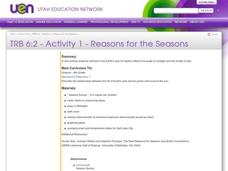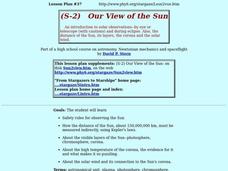Curated OER
How Much Energy Does the Earth Receive from the Sun?
Students explore energy. For this science lesson, students conduct an experiment in which they measure how much energy is produced by the sun. Students build a calorimeter to measure the amount of energy.
Curated OER
Learning From Leaves: A Look at Leaf Size
Students measure and analyze leaves from various environments. They discuss the environments, and make inferences about environmental variables that could have contributed to the differences in leaf size and texture.
Curated OER
Respiration
Students study the gas exchanges that occur during cellular respiration. They observe what happens as a result of a number of variables on the rate of respiration. They use microrespirometers to measure the oxygen consumption of...
Curated OER
The Grouchy Ladybug
Students complete a Cirlce Map about time. They recall times during the grouchy ladybugs travels, and add dots on ladybugs using turn-around facts. Pupils correctly sequence the events of The Grouchy Ladybug. Students compose new...
Curated OER
The Climate in Class
Students consider the implications of global warming. In this current events lesson plan, students visit selected websites to discover information about temperature rises in the world and discuss how to solve some of the issues...
Curated OER
Reasons for the Seasons
Sixth graders conduct and analyze a survey that explores public perceptions about the reasons for seasonal change. They measure the changing length of days, observe shadows and discuss how the Earth's axis of rotation affects the seasons.
Curated OER
Our View of the Sun
Students are introduced to safety rules for observing the Sun, how the distance of the Sun is measured using Kepler's Laws and identify the visible layers of the Sun. They discuss solar eclipses and view images of eclipses using the...
Curated OER
Strong as Newspaper
Students explore architecture. In this science lesson, students build a structure from newspaper. Students place weight on the structure to measure how strong the structure is.
Curated OER
Water Walk
Students follow the appropriate sampling protocol and take two measurements of a local water source. These measurements are Transparency and Temperature. This info about local land use and/or water chemistry issues may require further...
Curated OER
MLTI region
In this MLTI region instructional activity, students answer multiple choice questions about the MLTI region and other NASA missions. Students answer four questions.
Curated OER
What is the Mantle Like?
In these earth science worksheets student complete this project to model activity in the mantle, one Earth's four layers. The project includes liquid and powder materials in addition to several measuring components. Students must then...
Curated OER
Air Pressure and Wind
Fifth graders study air pressure and learn how it can change the weather. In this air pressure lesson, 5th graders study the given diagrams and complete the experiments to learn how air pressure can change the weather. Students read...
Curated OER
Keeping Warm?
Fifth graders explore conductors and heat loss in different materials. In this Physical Science lesson plan, 5th graders will be measuring the temperature drop of water in four containers. The class will then discuss what an insulator,...
Curated OER
Probability Of One Event
Learners investigate the concept of probability. They use example problems in order to measure the likelihood of various outcomes. The lesson includes dialogue to be used by the teacher during direct instruction. They also use class...
Curated OER
UV Rays
Fourth graders study the effects of UV rays and practice finding the UV index for where they live. In this health lesson plan, 4th graders listen to a lecture about ultraviolet rays, then find the UV index in their area and write a...
Curated OER
Water and Ice
Students explore the physical properties of water. In this water lesson, students explore water as it changes states. They observe, measure and use communication skills to describe change.
Curated OER
Observing Fall Migrants
Pupils observe the migration of monarch butterflies. They collect data regarding the number of monarchs they see, the location, the butterflies' behavior, the temperature and the date and time. Then they send their data to a university...
Alabama Learning Exchange
Is My Water Safe?
Learners discuss what makes their drinking water safe and unsafe. They locate and visit a local tributary and test the water's pH, hardness, dissolved oxygen, and total alkalinity. They compose a summary paragraph about the tests and...
Curated OER
Seasons
Students name the 4 seasons, discussing the weather, plant life, animal life and and activities of each. Students read the book titled, "Hello Arctic," and and discuss changes in seasons that accompany the story. Students complete...
Curated OER
Designing Local Studies
Students think about and identify significant aspects of local weather patterns by reflecting on their own observations. They design local weather studies by deciding which information to collect and how to collect and record it...
Curated OER
Water and Ice
Students investigate how water changes state. In this water lesson, students observe, measure, and describe water as it changes state. This lesson includes extensions which can be accessed via the provided web links.
Curated OER
Do You Have Change?
Students analyze data and complete a worksheet about land use change in a coastal region. In this land use lesson, students discuss events that cause land use changes in coastal areas. They construct a change table to summarize data on...
Curated OER
Soybean Science
Fourth graders explore food science by participating in a cooking activity. For this soybean oil lesson, 4th graders listen as the teacher gives them a background on soybeans and their use by humans today. Students grind soybeans and...
Pennsylvania Department of Education
Energy in Motion
Fifth graders explore energy transfer. In this thermal energy lesson, 5th graders stretch rubber bands several times and estimate the band's temperature change. Students identify this action as an example of thermal energy. Students...

























